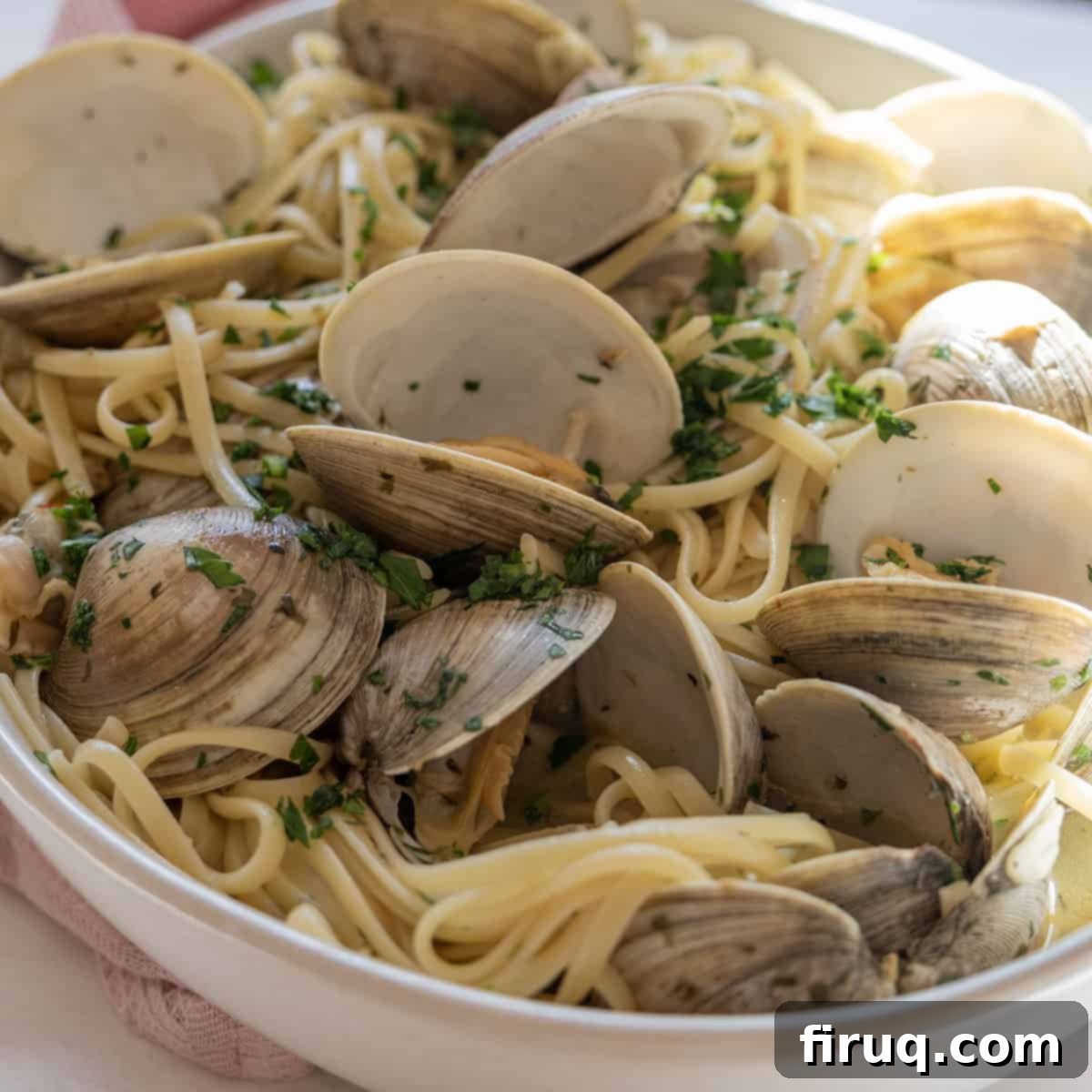Mastering Linguine with Clams: An Easy 30-Minute Italian Seafood Pasta Recipe
A cherished Christmas Eve tradition for our family, Linguine with Clams graces our holiday table every year. Yet, its incredible ease and delicious flavor mean it often finds its way into our weekly meal rotation, making it a true culinary staple.
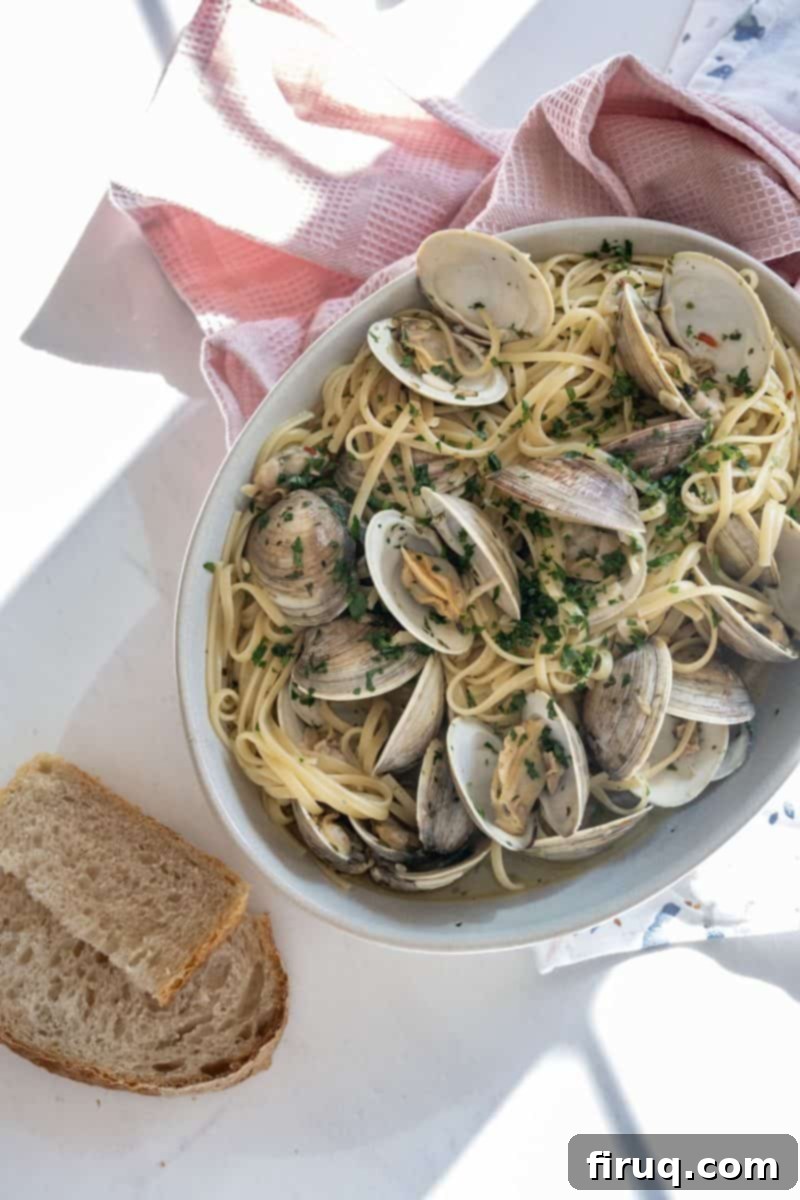
If you’re a big fan of pasta dishes featuring fresh seafood, you may also enjoy these other delectable options: Fra Diavolo Sauce with Shrimp, Lemon Pesto Spaghetti with Scallops, or Umami Shrimp Scampi.
[feast_advanced_jump_to]Why Every Home Cook Needs This Linguine with Clams Recipe
Looking to significantly enhance your seafood cooking skills? This Linguine with Clams recipe is an absolute must-add to your culinary repertoire. Beyond being incredibly delicious, mastering this dish empowers you with essential techniques that are applicable to a range of other seafood preparations. It’s a fantastic way to elevate your home cooking, offering a restaurant-quality meal without the fuss or lengthy preparation.
One of the primary reasons this recipe is so beloved is its efficiency. It’s truly a game-changer to have a recipe that tastes spectacular and can be cooked from start to finish in 30 minutes or less. Imagine serving this elegant yet simple dish to family and friends on a weeknight, or even for a special occasion, knowing you created something truly impressive in minimal time!
This dish, when prepared with fresh ingredients, consistently ranks as one of my absolute favorite recipes to make at home. Anyone, regardless of their cooking experience, can learn how to create this vibrant and flavorful pasta. And if you ever wish to explore a different flavor profile, you can easily switch it up with a rich red sauce by trying our Linguine with Red Clam Sauce, offering a delightful variation on this classic.
Sourcing the Best Clams for Your Pasta
For the ultimate flavor and texture in your Linguine with Clams, I personally recommend using a combination of fresh and canned clams. Specifically, I opt for fresh, local little neck clams alongside high-quality canned clams. The canned clams are fantastic for adding more substance to the dish and deepening the briny flavor of the sauce. While the recipe can certainly be made without them, this combination works wonderfully for our family and many others.
If you don’t live close to the ocean or finding fresh seafood is challenging in your area, don’t despair! This dish can still be incredibly tasty using solely canned clams. You’ll still achieve a delicious and satisfying meal, highlighting the robustness of the clam flavor. Just be sure to use a good brand of canned clams, preferably those packed in their own juice or a light white wine.
When you are able to purchase fresh clams, always seek out a seafood market that you trust. Do your research, look at their reviews, and ensure that all their seafood is properly stored and presented on ice. Freshness is paramount for safety and flavor.
Upon purchasing your clams, it’s vital to inspect them thoroughly before cooking. Discard any clams that have broken shells, or any that are open and do not close when lightly tapped. These are clear indications that the clam is no longer alive and safe to eat. Fresh, healthy clams are still living organisms and will keep their shells tightly closed until they are cooked and the heat forces them open. If a clam is slightly open, a gentle tap should make it close firmly. If it doesn’t, it’s best to discard it.
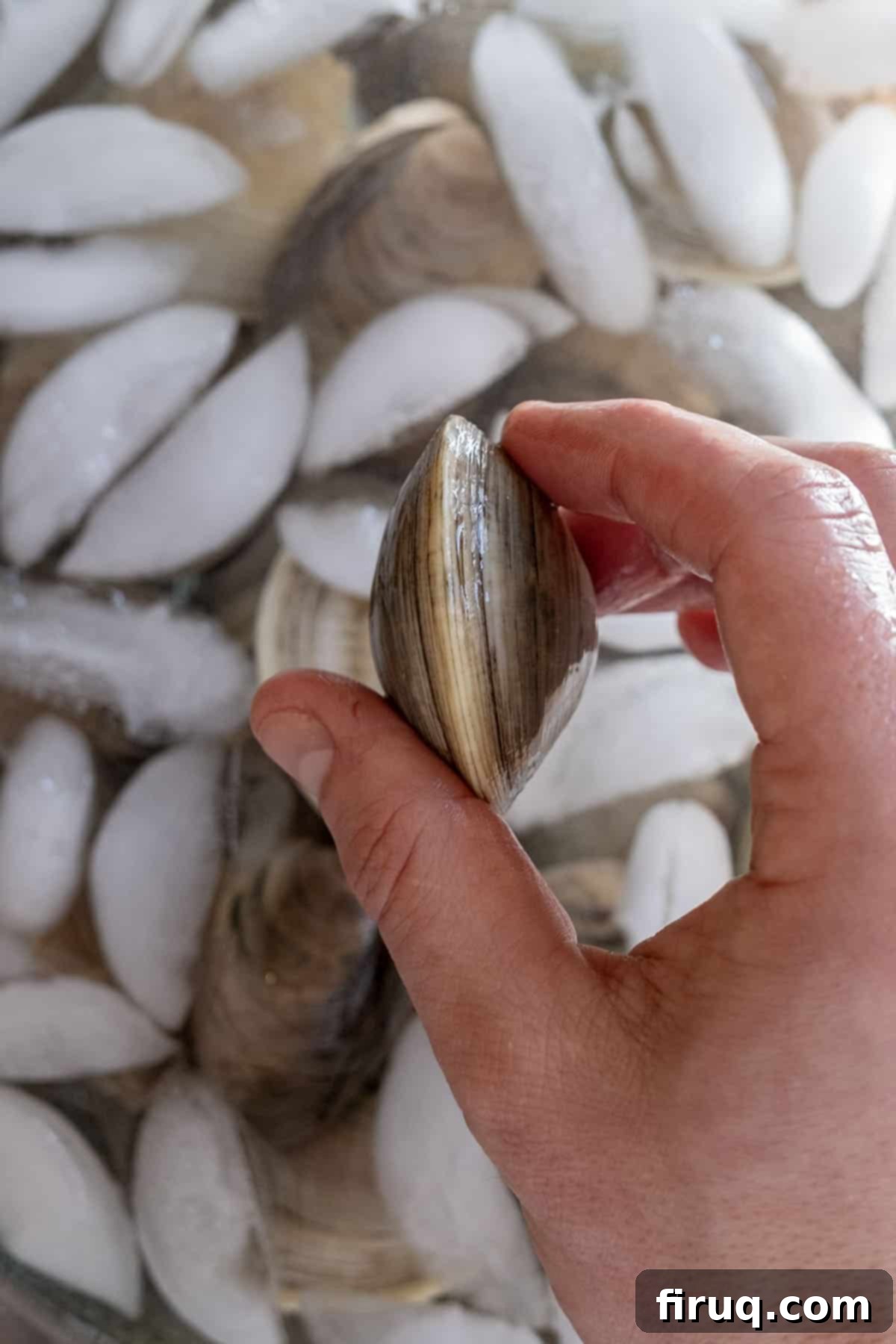
A healthy, vibrant clam will look exactly like the one pictured above: completely shut tight with no visible cracks or openings in its shell. This ensures you’re starting with the freshest possible seafood for your pasta.
The Essential Step: Purging Fresh Little Neck Clams
Before cooking, properly cleaning and purging your fresh clams is a non-negotiable step to ensure a grit-free, enjoyable meal. There is truly nothing worse than chewing on sandy pasta!
First, begin by thoroughly scrubbing the clam shells under cold running water. Use your hands or a stiff brush to remove any visible sand, dirt, or external debris that might cling to the outside of the shells. And please, just to be absolutely clear: DO NOT use soap or any chemical cleaners on your clams. Plain water is all you need.
Once the shells are clean, prepare an ice-cold water bath. Fill a large bowl or pot with water, add a generous amount of salt (about 1/3 cup of salt per gallon of water to mimic seawater salinity), and then add your clams. Allow the clams to soak and rest in this environment for 30-60 minutes. This process is called “purging the clams.” The cold, salty water encourages the clams, which are still alive, to “breathe” and filter the water, expelling any internal sand or grit they may have accumulated.
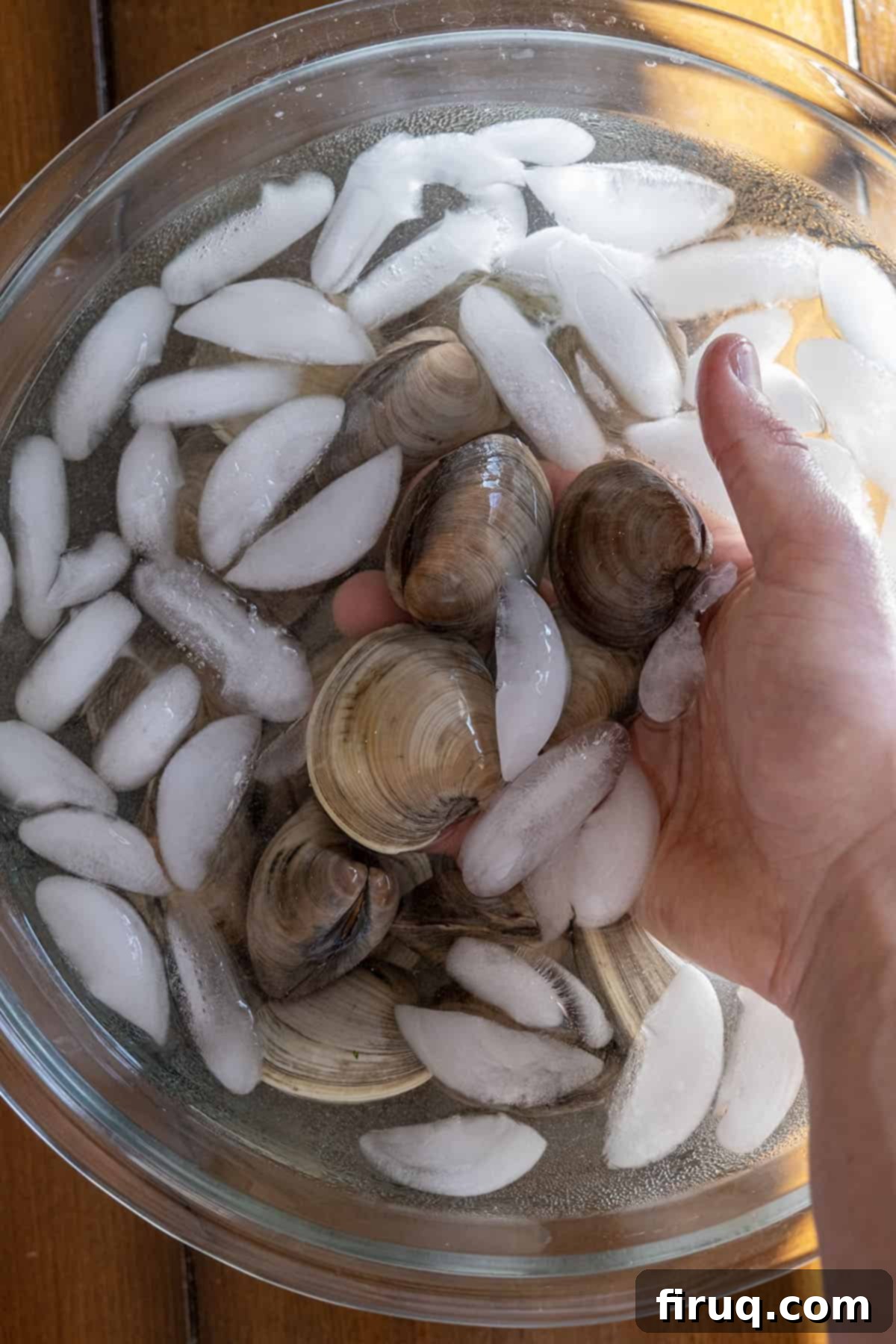
After the initial purge, carefully drain the water, which will likely contain some expelled sand. It’s often beneficial to repeat this process one more time with fresh, cold salted water to ensure maximum cleanliness. This double-purge method significantly reduces the chance of finding any unwelcome grit in your finished dish.
Once purged, give the clams a final rinse under cold water to wash away any lingering debris. Always remember to keep your clams on ice or in the coldest part of your refrigerator at all times until you are ready to cook them, ensuring they remain fresh and safe for consumption.
Effortless Steps to Crafting Perfect Linguine with Clams
Creating this iconic Italian seafood pasta is simpler than you might think. Follow these straightforward steps for a delicious meal:
Begin by setting up your cooking stations: heat a large saucepan or deep frying pan to medium heat for your sauce. Simultaneously, fill a large pot with water, generously salt it, and bring it to a rolling boil for your pasta. Cook the linguine until it’s just al dente, retaining a slight bite. Crucially, remember to save at least half a cup of that starchy pasta water before draining!
Step 1: Build the Flavor Base. Add extra virgin olive oil to your heated saucepan. Once the oil shimmers, add the minced garlic and a modest amount of red pepper flakes. The goal here is to infuse the oil with their aromatics, not to brown the garlic, which can turn bitter. Stir continuously to prevent burning.
A note on red pepper flakes: while some people prefer a spicier dish, this recipe shines with a delicate balance of flavors. A small amount provides a pleasant warmth that enhances the briny clams without overpowering the dish. Resist the urge to go overboard; we want complementary heat, not dominant spice.
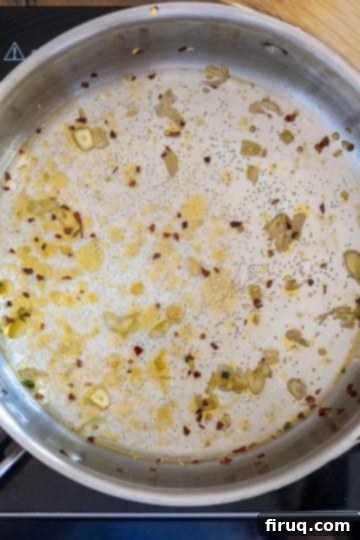
Step 2: Deglaze and Infuse. After about a minute of sautéing the garlic and chili, before the garlic even hints at turning brown, pour in the white wine, fresh lemon juice, lemon zest, and half of the fresh parsley. Stir everything together and bring the mixture to a gentle simmer. A dry, crisp white wine like Sauvignon Blanc or Pinot Grigio works best, adding acidity and depth without sweetness.
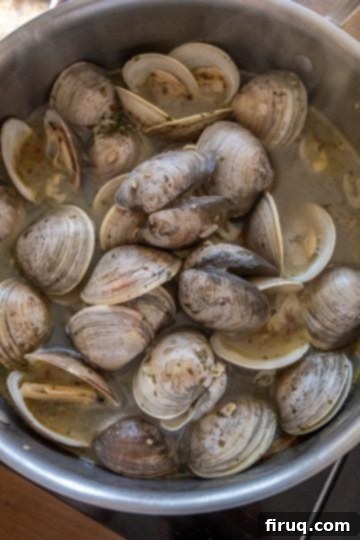
Step 3: Cook the Clams. Allow the sauce to simmer for about 5-7 minutes. During this time, it should begin to reduce slightly, concentrating its flavors and thickening. Next, pour in your canned clams (including their liquid) and return the sauce to a gentle simmer for another 5 minutes, allowing their briny essence to infuse the sauce. Then, carefully place your fresh, purged clams evenly in the pan with the simmering sauce, ensuring they have room to open. Immediately cover the saucepan tightly and let the clams steam for about 5 minutes.
When you lift the lid, you should see that the majority of the clams have opened. Promptly remove all opened clams from the pan and transfer them to a plate on the side. This prevents them from overcooking and becoming rubbery.
Any clams that remain stubbornly closed after this cooking period should be discarded. They were likely dead before cooking and are not safe or pleasant to eat.
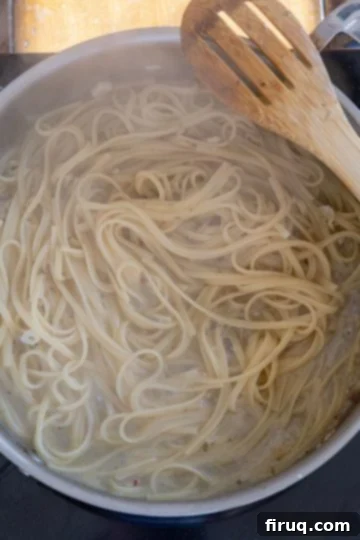
Step 4: Combine Pasta and Sauce. Strain your al dente pasta and immediately add it directly to the saucepan with the clam sauce. Stir in approximately ¼ to ½ cup of the reserved pasta water. Allow it to simmer gently while continuously stirring the pasta, ensuring every strand is beautifully coated with the flavorful sauce. The starchy pasta water helps emulsify the sauce, creating a silky texture that clings perfectly to the linguine. If the sauce seems too thick, add a little more pasta water until it reaches your desired consistency. Finally, sprinkle in the remaining fresh parsley for an aromatic finish.

Step 5: Final Toss and Serve. Return the cooked clams to the pan with the pasta and sauce, tossing everything together gently to combine. For a beautiful aesthetic presentation, I like to remove some of the clams from their shells and leave others in their shells, scattered throughout the pasta. This offers a lovely visual appeal and a mix of textures. Serve your exquisite Linguine with Clams immediately, perhaps with a side of crusty bread to soak up every last drop of the delicious sauce.
Traditionally, linguine with clams (especially the white wine sauce version) is not served with parmesan cheese. The subtle interplay of briny clams, bright lemon, fragrant garlic, and a hint of spice is truly meant to shine through on its own. Adding parmesan, especially a strong one, can indeed overpower these nuanced flavors. While parmesan is much more affordable and readily available these days, and many are accustomed to adding cheese to pasta, we highly encourage you to try this dish without the cheese first. Savor the authentic taste profile. If you absolutely must have cheese, a very light sprinkle of a mild, aged Pecorino Romano might be less intrusive than a sharp parmesan.
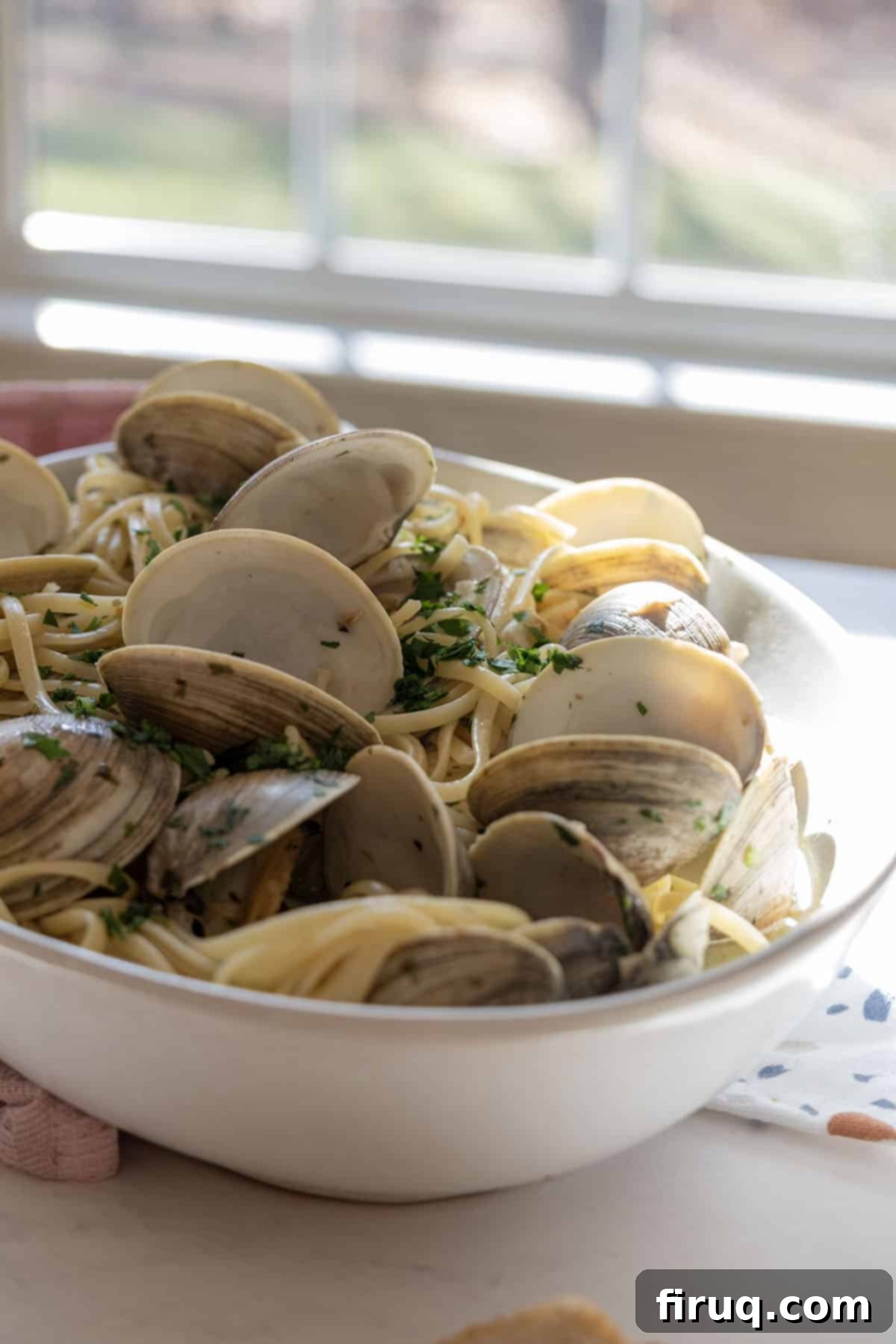
Pro-Tips for Perfect Linguine with Clams
- Achieve the Perfect Sauce Consistency: Patience is key here. Don’t be tempted to rush the simmering process. Once you add the canned clams, truly allow the sauce to simmer and reduce down. This ensures the flavors concentrate and the sauce thickens slightly, preventing it from being watery or “soupy” and allowing it to beautifully cling to the pasta.
- Give Clams Time and Space to Open: Not all clams will open at the exact same moment. After the initial 5-minute steaming, remove the clams that have already opened to prevent them from overcooking and becoming tough. Then, re-cover the pan and give the remaining, still-closed clams a few more minutes to open. Discard any clams that stubbornly refuse to open after sufficient cooking time, as they are not safe to eat.
Christmas Eve Recipes to Enhance Your Feast of the Seven Fishes
Linguine with Clams is a fantastic centerpiece for any seafood feast, especially the traditional Christmas Eve dinner. Here are some other delicious seafood recipes to complement your meal:
- For substantial fish fillets on the table, consider: Pistachio Crusted Fish, Lemon Garlic Broiled Flounder, or Cast Iron Lemon Dill Salmon.
- Some exquisite seafood appetizers to kick off your meal include: Italian Stuffed Baked Clams, The Best Homemade Shrimp Cocktail, Garlic Sage Seared Scallops, or Steamed Mussels in White Wine.
- If you love variety, we often feature more than one seafood pasta on our holiday table, such as: Fra Diavolo Sauce with Shrimp, Lemon Pesto Spaghetti with Scallops, or Umami Shrimp Scampi.
Linguine with Clams Recipe FAQs
For Linguine with Clams, I always reach for a dry, crisp white wine like Sauvignon Blanc or Pinot Grigio. My number one rule when cooking with wine is, “If I wouldn’t drink it, I won’t cook with it.” So, avoid the cheapest bottle on the shelf. Something middle-of-the-road in terms of quality should do just fine, as a good quality wine will significantly enhance the depth of flavor in your sauce.
The best way to reheat Linguine with Clams is on the stovetop. Place the leftovers in a pan over medium-low heat with a little extra virgin olive oil and a splash of water or white wine. Stir gently and occasionally until warmed through. This method prevents the pasta from drying out and helps rejuvenate the sauce, ensuring your leftovers taste almost as good as fresh.
Safety is paramount when cooking with shellfish. Always discard any clams that have broken shells before cooking. Furthermore, any clam that does not open during the cooking process should also be thrown away. Clams that remain closed are usually dead before cooking and are not safe to consume. It’s simply not worth the risk, so always carefully inspect your clams both before and after cooking.
Watch the Recipe: Linguine with Clams Tutorial
See every step in action with our detailed video recipe! It’s the perfect companion to ensure your Linguine with Clams turns out flawless.
Explore More Delicious Seafood Recipes
- Italian Stuffed Baked Clams
- Shrimp Fra Diavolo with Linguine
- Lemon Pistachio Crusted Snapper
- Pan-Seared Vermillion Snapper
Please leave a comment and star rating below in the recipe card! We love to hear what you think of our recipes and how they turn out for you. Feel free to tag us on Instagram @vindelgiudice to share your culinary creations!
📖 Recipe

Linguine with Clams
Vincent DelGiudiceEquipment
- 1 deep frying pan
Ingredients
- 1 lb linguine pasta
- 2 dozen fresh little neck clams, purged
- 10 oz can chopped clams in white wine or clam juice
- ¾ cup dry white wine (e.g., Sauvignon Blanc, Pinot Grigio)
- ¼ cup fresh parsley, chopped (divided)
- 3 tbsp extra virgin olive oil
- 6 cloves fresh garlic, minced
- 1 teaspoon red pepper flakes (adjust to taste)
- 1 tablespoon lemon zest
- ½ lemon, freshly juiced
Instructions
- Start by thoroughly cleaning the fresh clams. Rinse them under cold water, scrubbing to remove any external dirt or debris. Then, soak them in a large bowl of ice-cold, heavily salted water for 30-60 minutes. This purging process encourages the clams to expel any internal sand. Repeat the cold-water soak with fresh salted water one more time for best results. Meanwhile, you can begin preparing the rest of your ingredients.
- Heat your deep frying pan to medium heat. Pour in 2 tablespoons of extra virgin olive oil. Once the oil is shimmering, add the minced garlic and red pepper flakes. Sauté for 1-2 minutes, stirring frequently, being careful not to brown the garlic. Just before the garlic starts to change color, add the white wine, fresh lemon juice, lemon zest, and half of the chopped parsley. Bring the mixture to a simmer and allow it to cook for 5-7 minutes, stirring occasionally, until the sauce has slightly reduced and its flavors have concentrated.
- While the sauce simmers, bring a large pot of generously salted water to a rolling boil for your pasta. Add the linguine and cook according to package directions until it is just before al dente. Remember to reserve approximately ½ cup of the starchy pasta water before draining.
- Add the entire can of chopped clams (including their liquid) to the simmering sauce, stirring to combine, and return the sauce to a gentle simmer. Next, add the fresh, purged clams in a single layer to the sauce and cover the pan tightly. Allow the clams to steam for about 4-5 minutes. When you remove the cover, most clams should have opened. Immediately remove all opened clams and place them on a separate plate. If any clams have not yet opened, recover the pan and give them another 2-3 minutes. Discard any clams that remain closed after this extended cooking time.
- Once all the cooked clams have been removed from the sauce, add your nearly al dente linguine to the pan. Pour in about ½ cup of the reserved pasta water. Stir the pasta continuously until it is completely coated in the sauce and the sauce has emulsified, clinging beautifully to the pasta. If the sauce seems too thick, add a little more pasta water until it reaches your desired consistency. Once the pasta is perfectly coated, remove the pan from the heat, stir in the remaining fresh parsley, and gently fold the cooked clams back into the pasta. Serve immediately for the best flavor and texture.
Notes
-
- Sauce Reduction is Key: Don’t be impatient. Allowing the sauce to simmer and reduce, especially after adding the canned clams, is crucial. This step concentrates the flavors and ensures your sauce isn’t watery, but rather a rich, clinging coating for your pasta.
- Handle Clams with Care: When cooking fresh clams, it’s normal for them to open at different rates. Promptly remove opened clams from the pan to prevent overcooking and give any still-closed clams a bit more time to steam open. Always discard clams that do not open, as they are not safe to eat.
